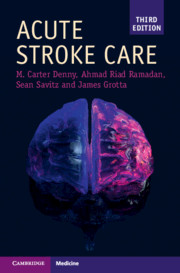Book contents
- Acute Stroke Care
- Acute Stroke Care
- Copyright page
- Contents
- Preface to the Third Edition
- Abbreviations
- Chapter 1 Stroke in the Emergency Department
- Chapter 2 What to Do First
- Chapter 3 Ischemic Stroke
- Chapter 4 Stroke Radiology
- Chapter 5 Intravenous Thrombolysis
- Chapter 6 Endovascular Therapy
- Chapter 7 Neurological Deterioration in Acute Ischemic Stroke
- Chapter 8 Ischemic Stroke Etiology and Secondary Prevention
- Chapter 9 Transient Ischemic Attack
- Chapter 10 Less Common Causes of Stroke
- Chapter 11 Cerebral Venous Sinus Thrombosis
- Chapter 12 Intracerebral Hemorrhage
- Chapter 13 Subarachnoid Hemorrhage
- Chapter 14 Organization of Stroke Care
- Chapter 15 Stroke Rehabilitation
- Chapter 16 Transition to Outpatient Stroke Care
- Book part
- Further In-Depth Reading
- Index
- Plate Section (PDF Only)
- References
Chapter 5 - Intravenous Thrombolysis
Published online by Cambridge University Press: 28 October 2019
- Acute Stroke Care
- Acute Stroke Care
- Copyright page
- Contents
- Preface to the Third Edition
- Abbreviations
- Chapter 1 Stroke in the Emergency Department
- Chapter 2 What to Do First
- Chapter 3 Ischemic Stroke
- Chapter 4 Stroke Radiology
- Chapter 5 Intravenous Thrombolysis
- Chapter 6 Endovascular Therapy
- Chapter 7 Neurological Deterioration in Acute Ischemic Stroke
- Chapter 8 Ischemic Stroke Etiology and Secondary Prevention
- Chapter 9 Transient Ischemic Attack
- Chapter 10 Less Common Causes of Stroke
- Chapter 11 Cerebral Venous Sinus Thrombosis
- Chapter 12 Intracerebral Hemorrhage
- Chapter 13 Subarachnoid Hemorrhage
- Chapter 14 Organization of Stroke Care
- Chapter 15 Stroke Rehabilitation
- Chapter 16 Transition to Outpatient Stroke Care
- Book part
- Further In-Depth Reading
- Index
- Plate Section (PDF Only)
- References
Summary
The only treatment that has been proven to improve outcome after ischemic stroke is to reperfuse the brain by removing the arterial obstruction. All animal and clinical studies show that brain tissue exposed to the reduced blood flow inherent after an arterial occlusion dies quickly, in proportion to the reduction of flow. Brain tissue where there is the most profound reduction of flow (the ischemic “core”) dies within minutes. In areas where flow is less severely reduced (the ischemic “penumbra”), tissue death occurs more gradually, dependent on the adequacy of collateral flow. The faster that normal flow can be re-established, the less tissue death and the less consequent disability occurs. This chapter deals with systemic thrombolysis.
- Type
- Chapter
- Information
- Acute Stroke Care , pp. 58 - 79Publisher: Cambridge University PressPrint publication year: 2019



